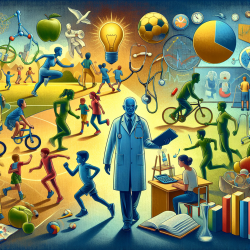Introduction
As a speech-language pathologist deeply committed to improving children's outcomes, understanding the multifaceted influences on children's health-related quality of life (HRQoL) is crucial. A recent study, "Association of Socioeconomic Factors and Physical Activity with Health-Related Quality of Life in Italian Middle School Children," provides valuable insights into how socioeconomic factors and physical activity impact children's well-being. This blog will explore the study's findings and discuss how practitioners can apply these insights to enhance children's HRQoL.
Understanding the Study
The study examined 224 Italian middle school children, focusing on how socioeconomic status (SES), physical activity (PA), and cardio fitness (CF) influence HRQoL. Using a multivariate path regression model, the researchers found that younger students and females reported higher HRQoL. Additionally, children with both parents employed and higher familial educational status experienced better quality of life. Regular engagement in moderate to vigorous physical activity significantly improved HRQoL, highlighting the importance of promoting physical activity among children.
Key Findings
- Younger students and females reported higher HRQoL.
- Higher familial educational status and both parents being employed were associated with better HRQoL.
- Regular physical activity, particularly moderate to vigorous intensity, was positively correlated with HRQoL.
- Endurance and speed were linked to improved HRQoL, while slower shuttle run times indicated lower HRQoL.
Implications for Practitioners
Practitioners can leverage these findings to enhance children's HRQoL by:
- Encouraging regular physical activity: Schools and parents should promote activities that increase children's endurance and speed.
- Addressing socioeconomic disparities: Efforts to support families with lower SES can contribute to improved HRQoL for children.
- Implementing school-based interventions: Programs like "Active Breaks" can integrate physical activity into the school day without disrupting academic instruction.
Encouraging Further Research
While this study provides valuable insights, further research is needed to explore additional factors influencing HRQoL, such as nutrition, cultural influences, and family dynamics. Expanding the scope of research can help develop more comprehensive interventions tailored to diverse populations.
Conclusion
The study underscores the importance of addressing both socioeconomic factors and physical activity to enhance children's HRQoL. By implementing targeted interventions and promoting regular physical activity, practitioners can significantly impact children's well-being and future outcomes. For those interested in delving deeper into the research, the original paper provides a comprehensive analysis of these critical factors.
To read the original research paper, please follow this link: Association of Socioeconomic Factors and Physical Activity with Health-Related Quality of Life in Italian Middle School Children: An Exploratory Cross-Sectional Study.










